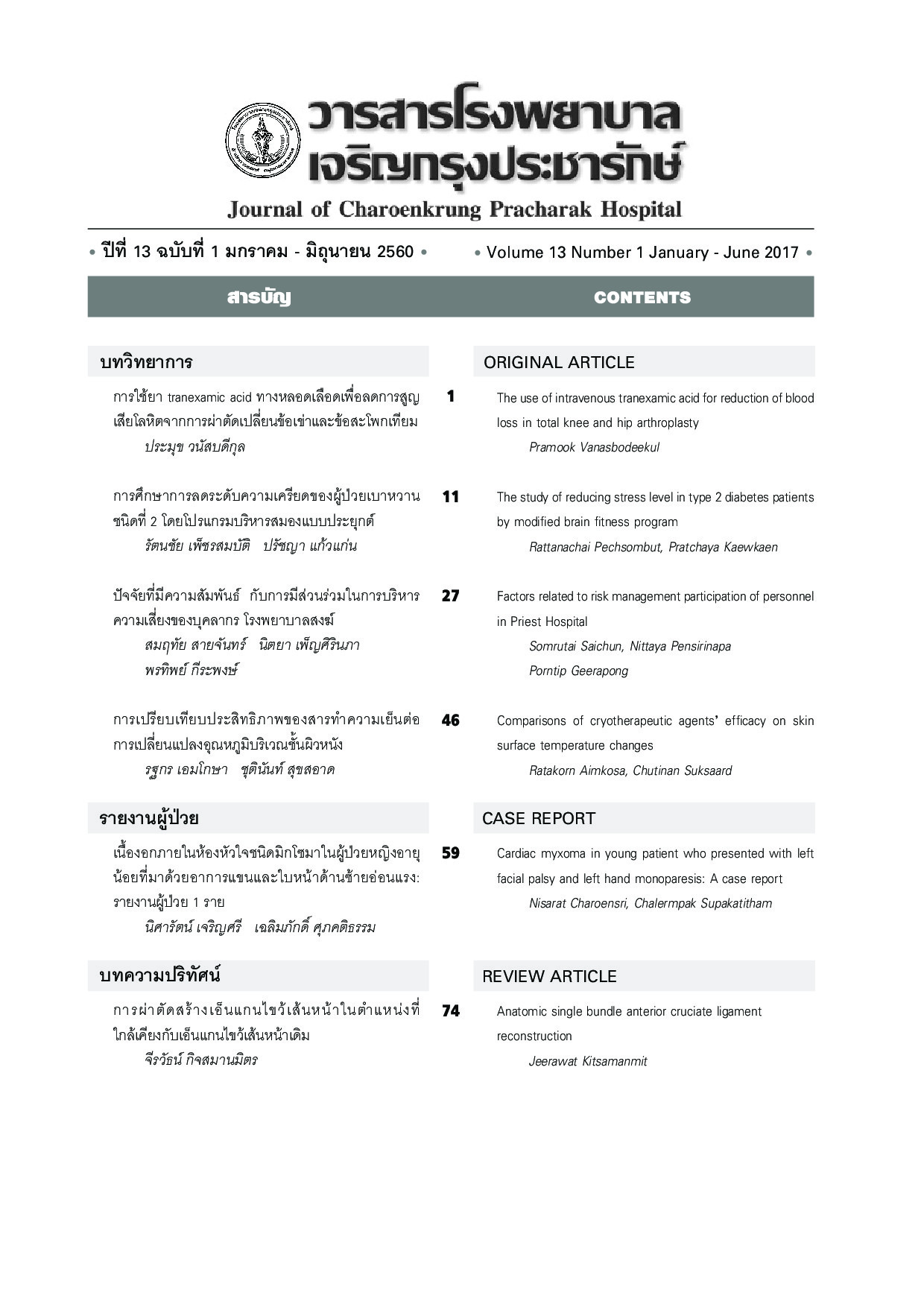การผ่าตัดสร้างเอ็นแกนไขว้เส้นหน้าในตำแหน่งที่ใกล้เคียงกับเอ็นแกนไขว้เส้นหน้าเดิม
Main Article Content
บทคัดย่อ
บทนำ: ภาวะบาดเจ็บของเอ็นแกนไขว้เส้นหน้า (anterior cruciate ligament injuries) พบได้บ่อยในกลุ่มประชากรที่เล่นกีฬาสามารถทำการรักษาได้โดยการผ่าตัดสร้างเอ็นแกนไขว้เส้นหน้า (anterior cruciate ligament reconstruction (ACLR) ซึ่งเป็นมาตราฐาน (gold standard) ของการรักษาภาวะนี้ จุดประสงค์หลักของการผ่าตัด ACL reconstruction คือ การแก้ไขภาวะการเคลื่อนไหวของข้อเข่าที่ผิดปกติในผู้ป่วยที่มีการฉีกขาดของเอ็นแกนเข่าไขว้เส้นหน้าและเพื่อสร้างความมั่นคงให้เกิดขึ้นภายในข้อเข่าเพื่อให้ผู้ป่วยได้กลับไปใช้งานหรือเล่นกีฬาได้
วัตถุประสงค์: เพื่อทบทวนวรรณกรรมที่เกี่ยวกับกายวิภาคของเอ็นแกนไขว้เส้นหน้าและผลการผ่าตัดของการผ่าตัดสร้างเอ็นแกนไขว้เส้นหน้าในตำแหน่งที่ใกล้เคียงกับเอ็นแกนไขว้เส้นหน้าเดิมโดยเทคนิค single bundle และ เทคนิค double-bundle
วิธีการดำเนินการวิจัย: เป็นการทบทวนวรรณกรรม
ผลการศึกษา: ปัจจุบันมีการศึกษาวิจัยเกี่ยวกับกายวิภาคของเอ็นแกนไขว้เส้นหน้า (ACL) พบว่าประกอบด้วยเส้นเอ็นสองส่วนคือ anteromedial และ posterolateral bundle การผ่าตัดสร้างเอ็นแกนไขว้เส้นหน้าโดยเทคนิค double-bundle (double bundle ACL reconstruction) จึงถูกคิดค้นขึ้น แต่การผ่าตัดนั้นทำได้ยากกว่าการผ่าตัดแบบเดิมใช้เวลาในการผ่าตัดมากขึ้น การยึดตรึงของ graft ทำได้ยาก ไม่เหมาะสมกับผู้ป่วยที่มีขนาดจุดเกาะเอ็นแกนไขว้เส้นหน้าบริเวณกระดูกหน้าแข้งที่มีขนาดแคบหรือมีขนาดเล็กกว่า 14 มิลลิเมตร จึงมีความสนใจการผ่าตัดสร้างเอ็นแกนไขว้เส้นหน้าเส้นเดียวในตำแหน่งที่ใกล้เคียงกับเอ็นแกนไขว้เส้นหน้าเดิม (anatomic single bundle ACL reconstruction) ซึ่งวางในตำแหน่งเดิมของเอ็นแกนไขว้เส้นหน้า (anatomic ACL) ให้ตำแหน่งอยู่ระหว่างสอง bundle โดยเจาะ femoral tunnel ผ่านทาง anteromedial portal ผลการผ่าตัดด้วยเทคนิค double bundle ACLR มีความมั่นคงของเข่าในแนว anterior translation และ rotational stability ที่ดีกว่าและมีค่าคะแนน IKDC (International Knee Documentation Committee knee scoring) ที่สูงกว่า อย่างไรก็ตามค่าที่ได้มีปริมาณที่แตกต่างเพียงเล็กน้อย
สรุปผลการวิจัย: การผ่าตัดสร้างเอ็นแกนไขว้เส้นหน้าได้รับการพัฒนาจากเทคนิค trans-tibial tunnel ไปยังเทคนิค double-bundle แต่การผ่าตัดโดยเทคนิค double-bundle มีความยุ่งยากและผลการรักษาทางคลินิก เมื่อเปรียบเทียบกับเทคนิค single bundle ยังไม่ดีกว่าอย่างชัดเจน และความใส่ใจเกี่ยวกับกายวิภาคของเอ็นแกนไขว้เส้นหน้าทำให้เทคนิคการผ่าตัดสร้างเอ็นแกนไขว้เส้นหน้าเส้นเดียวในตำแหน่งที่ใกล้เคียงกับเอ็นแกนไขว้เส้นหน้าเดิม (anatomic single bundle ACL reconstruction) กลับมาได้รับความสนใจ
คำสำคัญ: เอ็นแกนไขว้เส้นหน้า การผ่าตัดสร้างเอ็นแกนไขว้เส้นหน้าในตำแหน่งที่ใกล้เคียงกับเอ็นแกนไขว้เส้นหน้าเดิม
Article Details
เอกสารอ้างอิง
ligament reconstruction. Curr Rev Musculoskeletal Med 2011; 4(2): 65-72.
2. Marx RG, Jones EC, Angel M, Wickiewicz TL, Warren RF. Beliefs and attitudes of members of the
American Academy of Orthopaedic Surgeons regarding the treatment of anterior cruciate ligament
injury. Arthroscopy 2003; 19(7): 762-70.
3. Griffin LY, Albohm MJ, Arndt EA. Understanding and preventing non-contact ACL injuries. A
review of the Hunt Valley II meeting January 2005. Am J Sports Med 2006; 34: 1512-32.
4. Lohmander LS, Englund PM, Dahl LL. The long term consequence of anterior cruciate ligament and
meniscus injuries: osteoarthritis. Am J Sports Med 2007; 35(10): 1756-69.
5. Hardin GT, Bach BR, Bush-Joseph CA. Endoscopic single-incision anterior cruciate ligament
reconstruction using patellar tendon autograft. Am J Knee Surg 1992; 5: 144-55.
6. Charles Brown Jr, United Arab Emirates. Anatomic ACL reconstruction. Sports medicine journal
ASPETAR: 556-65.
7. Zaricznyj B. Reconstruction of anterior cruciate ligament of the knee using a doubled tendon graft. Clin
Orthop Relat Res 1987; Jul(220): 162-75.
8. Brown CH, Spalding T, Robb C. Medial portal technique for single-bundle anatomical anterior cruciate
(ACL) reconstruction. Int Orthop 2013; 37: 253-69.
9. Van Eck CF, Lesmiak BP, Schreiber VM, Fu FH. Anatomic single- and double-bundle anterior cruciate
ligament reconstruction flowchart. Arthroscopy 2010; 26: 258-68.
10. Zantop T, Petersen W. Anatomy of the Anterior Cruciate Ligament. Oper Tech Orthop 2005; 15: 20-8.
11. Harner CD, Baek GH, Vogrin TM, Quantitative analysis of human cruciate ligament insertion.
Arthroscopy 1999; 15; 741-9.
12. Palmer I, On the injuries to the ligaments of the knee joint: a clinical study. Acta Chir Scand 1938;
81: 1-282.
13. Ziegler CG, Pietrini SD, Westerhaus BD. Arthroscopically pertinent land marks for tunnel positioning
in single-bundle and double bundle anterior cruciate ligament reconstruction. Am J Sports Med 2011;
39(4): 743-52.
14. Zantop T, Petersen W. Therole of the anteromedial and posterolateral bundles of the Anterior Cruciate
Ligament in anterior tibial translation and internal rotation. Am J Sports Med 2007; 35(2): 223-7.
15. Prodomos CC, Joyce BT, Shi K, Keller BL. A meta-analysis of stability after anterior cruciate
ligament reconstruction as a function of hamstring versus patellar tendon graft and fixation type,
Arthroscopy 2005; 21: 1202-8.
16. Liden M, Ejerhed L, Sernert N, Laxdal G, Kartus J. Patellar tendon or semitendinosus tendon
autografts for anterior cruciate ligament reconstruction: A prospective, randomized study with a 7-year
follow-up. Am J Sports Med 2007; 35: 740-8.
17. Shino K, Suzuki T, The Resident’s ridge as an arthroscopic landmark for anatomic femoral tunnel
drilling in ACL reconstruction. Knee Surg Sports Traumatol Arthrosc 2010; 18: 1164-8.
18. Noyes F, Knee disorders: Surgery, Rehabilitation, Clinical Outcomes, Saunders 2009.
19. Lubowitz JH. Anteromedial portal technique for the anterior cruciate ligament femoral socket: Pitfalls
and solutions. Arthroscopy 25: 95-101.
20. Hussein M, Van Eck CF, Fu FH. Prospective Randomized Clinical Evaluation ofconventional single
bundle,anatomic single bundle, and anatomic double bundle anterior cruciate ligament
reconstruction:281 Cases with 3-to 5-Year Follow-up. Am J Sports Med 2012; 40(3): 512-20.
21. Xu M, Gao S, Zeng C, et al. Outcomes of anterior cruciateligament reconstruction using single-bundle
versusdouble-bundle technique: Meta-analysis of 19 randomizedcontrolled trials. Arthroscopy 2013;
29: 357-65.


